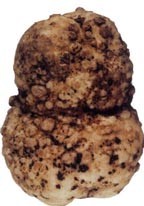Root knot nematode
Root knot nematodes, or eel worms, belong to the genus Meloidogyne, which includes the following species:
- M. arenaria
- M. hapla
- M. incognita
- M. javanica.
They infest a wide range of plants and are the most economically damaging of all the nematode species to agricultural crops worldwide. Potatoes are particularly susceptible, but only in warm areas. Generally, root knot nematodes are not a major problem in the cool production districts. The greatest losses occur where potatoes are grown intensively or rotated with other susceptible crops.
Symptoms
Infested potato plants may show varying degrees of stunting, yellowing of leaves and a tendency to wilt under moisture stress. Roots have swellings or galls, and beads or knots (hence the common name). Affected tubers have blisters or swellings. Symptoms are most severe when crops are grown on sandy soils and warm climates above 25°C.
Root knot nematode reduces the quality, size and number of tubers. Infested potatoes can become more susceptible to bacterial wilt, which is caused by Ralstonia solanacearum. Also, symptoms are more severe when plants are also infected with fungal pathogens such as Verticillium and Rhizoctonia.

Description
Nematodes or eelworms are small (less than 1 mm in length) soil-borne pests which attack plant roots. They are the most common multicellular organisms in soil.
Biology
Juvenile nematodes hatch from egg masses (eggs surrounded by a gelatinous layer) deposited by females. Juveniles move through the soil to the plant roots where they use a needle-like stylet to puncture roots (just behind the root tip) and suck out the cell contents. After entering the plant, the juvenile nematodes undergo a series of moults. On becoming adults, the males leave the roots while the females stay in the roots and continue to feed.
Invasion and feeding by the female nematode stimulate the host cells to enlarge and multiply into giant cells, causing the galls on the roots. Once a female nematode establishes a feeding site, her body enlarges and protrudes through the root. After mating, she lays eggs in a sticky substance on the outside of her body. Some species of root knot nematode can produce eggs without males. In temperate climates, generation time is four to six weeks and there are usually three or four generations per year.
Survival
Nematodes survive in the soil as egg masses. The gelatinous layer around the egg masses provides protection against desiccation and chemicals. Each female produces 500 to 1000 eggs. Eggs hatch under favourable conditions and juvenile nematodes infest roots of potatoes and other host plants.
Root knot nematodes also survive in the absence of potatoes by infesting alternative hosts, including many weed species.
Few species, except M. hapla, can survive extreme cold.
Host range
Potato (Solanum species) and over 2000 other plant species, including many species of vegetables and weeds.
Control
There are no potato cultivars that are resistant to root knot nematode. Chemical control is difficult and may not be economical for most Victorian potato growers.
Use the following methods to control root knot nematode:
- Monitor crops for symptoms of root knot nematode infestations.
- Practise good farm hygiene.
- Avoid planting susceptible crops in paddocks contaminated with root knot nematodes.
- Rotate crops with resistant, immune or non-host crops such as grasses (sudan grass) or cereals (barley, rye, wheat) in combination with a weed-free fallow to reduce nematode numbers. Many pasture legumes, such as white clover, and the common weed fat hen or Chenopodium species, are very susceptible to root knot nematode.
Correct diagnosis is essential for effective pest and disease control.
Reporting an unusual plant insect pest or disease
Report any unusual plant pest or disease immediately using our online reporting form or by calling the Exotic Plant Pest Hotline on 1800 084 881. Early reporting increases the chance of effective control and eradication.
Please take multiple good quality photos of the pests or damage to include in your report where possible, as this is essential for rapid pest and disease diagnosis and response.
Your report will be responded to by an experienced staff member, who may seek more information about the detection and explain next steps.
Report onlineAcknowledgment
The text here is based on the 'Agnote' publication developed by Jillian Hinch, La Trobe University, Bundoora in April 1999, and then reviewed by Kathy Pullman and Gordon Berg, Plant Standards, DPI in April 2006 and January 2010.